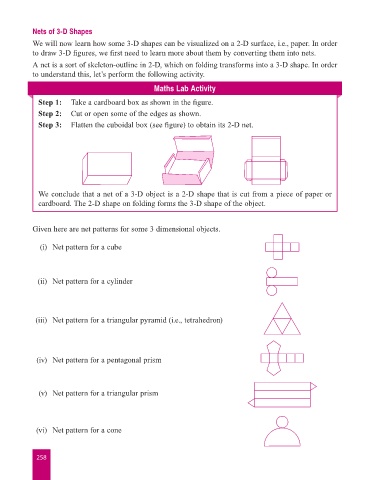Page 266 - Start Up Mathematics_7
P. 266
Nets of 3-D Shapes
We will now learn how some 3-D shapes can be visualized on a 2-D surface, i.e., paper. In order
to draw 3-D figures, we first need to learn more about them by converting them into nets.
A net is a sort of skeleton-outline in 2-D, which on folding transforms into a 3-D shape. In order
to understand this, let’s perform the following activity.
Maths Lab Activity
Step 1: Take a cardboard box as shown in the figure.
Step 2: Cut or open some of the edges as shown.
Step 3: Flatten the cuboidal box (see figure) to obtain its 2-D net.
We conclude that a net of a 3-D object is a 2-D shape that is cut from a piece of paper or
cardboard. The 2-D shape on folding forms the 3-D shape of the object.
Given here are net patterns for some 3 dimensional objects.
(i) Net pattern for a cube
(ii) Net pattern for a cylinder
(iii) Net pattern for a triangular pyramid (i.e., tetrahedron)
(iv) Net pattern for a pentagonal prism
(v) Net pattern for a triangular prism
(vi) Net pattern for a cone
258

